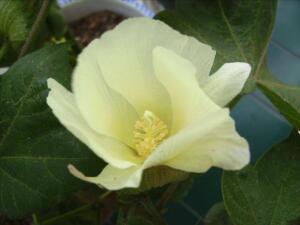
※The image shows a cotton flower. There are stamens and pistils.
I have told you about F1 several times in the past, but until I started growing cotton in 2008, I had no idea that there was such a thing as an F1 seed.
When I grew the seeds I bought from the seed store and sowed the seeds taken out of the cotton balls in the field the following year, they hardly germinated. I was curious and did some research, and that's how I learned about F1 seeds. I also learned that in English we call them hybrids.
Since I had a difficult time collecting seeds for sowing this season, I would like to take this opportunity to tell you all about seeds. F1 seeds are affecting not only cotton, but also grains, vegetables, and fruits on many household tables. (I will discuss this later.)
Now, how does an F1 seed work? Let me try to explain it in a very simplified way, using cotton as an example.
There are two types of cotton depending on where you are. A "normal" cotton has stamens and pistils in one flower.
○ Cotton A is characterized by small cotton balls but strong fibers.
○ Cotton B is characterized by large cotton balls but weak fiber strength.
What is desirable for humans is a trait in which the cotton balls are large and the fibers are strong. In order to have such traits, they must be artificially modified.
Cotton A and Cotton B species each have their own flowers. Each flower has a stamen and a pistil. The F1 variety is created by modifying the stamens and pistils in one flower so that they do not self-pollinate.
In a rudimentary method, pull out all the stamens of a Cotton A flower with tweezers to leave only the pistil. Then, only the pollen from the stamens of Cotton B is pollinated by the pistil of Cotton A. In other words, a complete hybrid is created.
The resulting hybrid is the F1 variety, AB, which has a larger cotton ball and stronger fibers. Cotton balls are also more uniform in size. This is due to a genetic mechanism called "hybrid vigor.
What happens when seeds from the newly created cotton, AB seeds, are sown the following year, they rarely germinate. Even if they germinate and grow, they die in the process or become cotton balls, but they will be small and immature.
F1 is a breed that is only one generation old and does not inherit the characteristics of its parents. This is why it is called First and Final.
Why is it only one generation? The reason is that the technology used to create F1 seeds is artificial, out of step with the workings and providence of the great cycle of life as a whole.
( to be continued )
